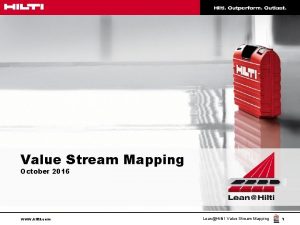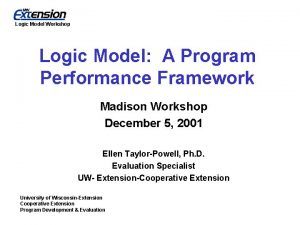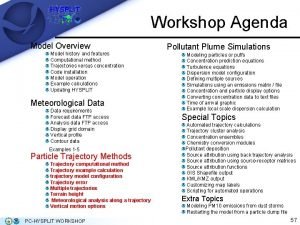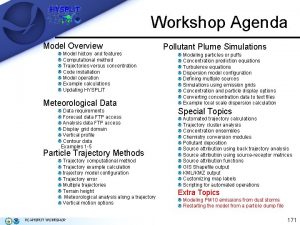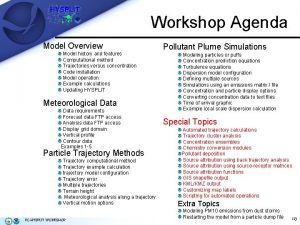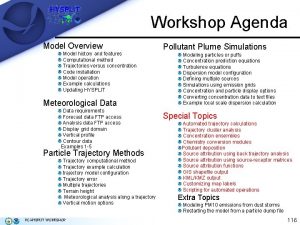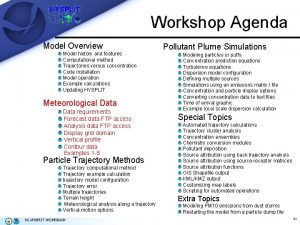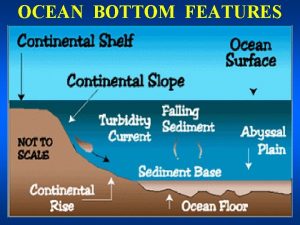Workshop Agenda Model Overview Model history and features














- Slides: 14

Workshop Agenda Model Overview Model history and features Computational method Trajectories versus concentration Code installation Model operation Example calculations Updating HYSPLIT Meteorological Data requirements Forecast data FTP access Analysis data FTP access Display grid domain Vertical profile Contour data Examples 1 -5 Particle Trajectory Methods Trajectory computational method Trajectory example calculation trajectory model configuration Trajectory error Multiple trajectories Terrain height Meteorological analysis along a trajectory Vertical motion options PC-HYSPLIT WORKSHOP Pollutant Plume Simulations Modeling particles or puffs Concentration prediction equations Turbulence equations Dispersion model configuration Defining multiple sources Simulations using emission grids Concentration and particle display options Converting concentration data to text files Example local scale dispersion calculation Special Topics Automated trajectory calculations Trajectory cluster analysis Concentration ensembles Chemistry conversion modules Pollutant deposition Source attribution using back trajectory analysis Source attribution using source-receptor matrices Source attribution functions GIS Shapefile output KML/KMZ output Customizing map labels Scripting for automated operations Extra Topics Modeling PM 10 emissions from dust storms Restarting the model from a particle dump file 21

Data Requirements File characteristics and projection HYSPLIT requires that meteorological data fields be: projected on a conformal map projection (Polar Stereographic, Lambert, or Mercator) or a regular latitude-longitude grid, organized with one record per variable per level and all records must have the same record length, written in a forward time sequence. More details on the format and packing of the meteorological data can be found in the HYSPLIT User's Guide. The exec directory contains several command line programs (chk_data, chk_rec) that can be used to analyze a HYSPLIT compatible meteorological data file. chk_file has been incorporated into a HYSPLIT GUI under the Meteorology / Display Data menu. PC-HYSPLIT WORKSHOP 22

Data Requirements Running Check File prompts the user for the location of a HYSPLIT compatible dataset. (Note: its best to store all HYSPLIT compatible data sets in a directory whose name does not contain spaces as these can sometimes confuse the TCL scripts). A sample of section 1 of the full output from Check File (chk_file) is shown (right) for the 12 km NAM forecast file from December 19, 2005, 1200 UTC. (Note: the source code for chk_file can be found in examplessource and can be used to develop other programs that need to read the meteorological data). PC-HYSPLIT WORKSHOP 23

Data Requirements Meteorological Variables A unique 4 -character string identifies meteorological variables. Minimum requirements to run the model are the U and V wind components (UWND, VWND), ambient temperature (TEMP), height (HGTS) of the data level (if on pressure coordinates), and the surface pressure (PRSS). A sample extract of section 2 of the chk_file program is shown below for the NAM 12 km dataset for levels between the surface and 925 h. Pa. Index Level # Variable listing and checksum values. . . 5 925. 0000 7 UWND 108 VWND 236 HGTS 230 TEMP 123 WWND 82 RELH 20 TKEN 47 4 950. 0000 7 UWND 147 VWND 129 HGTS 103 TEMP 89 WWND 155 RELH 121 TKEN 86 3 975. 0000 7 UWND 47 VWND 209 HGTS 178 TEMP 193 WWND 125 RELH 252 TKEN 82 2 1000. 0000 7 UWND 49 VWND 234 HGTS 138 TEMP 124 WWND 234 RELH 62 TKEN 198 1 0. 0000 14 SHGT 101 MSLP 235 TPP 3 184 CPP 3 184 T 02 M 215 RH 2 M 41 U 10 M 119 V 10 M 212 PRSS 53 LHTF 120 SHTF 206 USTR 215 RGHS 177 DSWF 194 PC-HYSPLIT WORKSHOP 24

Data Requirements Data Records Each data record is composed of a 50 byte ASCII header portion, describing the data packing, followed by the packed data of length (I*J bytes). One-byte per element “difference packing” is used for all data fields. The first data record (INDX) of each time period contains information on the variables, levels, grid, and checksums to follow. An extract of the final section from chk_file is shown below for the NAM 12 km data set. Definitions: YYMMDDHH = date/time (UTC) FH = forecast hour LL = vertical level GG = grid number FLD = field label EXP = scaling exponent PREC = precision of packed data VAR(1, 1) = data value at (1, 1) PC-HYSPLIT WORKSHOP # YYMMDDHHFHLLGG 1 5121912 0 099 2 5121912 0 099 3 5121912 0 099 4 5121912 0 099 5 5121912 0 099 6 5121912 0 099 7 5121912 0 099 8 5121912 0 099 9 5121912 0 099 10 5121912 0 099 11 5121912 0 099 12 5121912 0 099 13 5121912 0 099 14 5121912 0 099 15 5121912 0 099 16 5121912 0 199 17 5121912 0 199 18 5121912 0 199 19 5121912 0 199 20 5121912 0 199 21 5121912 0 199 22 5121912 0 199 23 5121912 0 299 24 5121912 0 299. . . . FLD INDX SHGT MSLP TPP 3 CPP 3 T 02 M RH 2 M U 10 M V 10 M PRSS LHTF SHTF USTR RGHS DSWF UWND VWND HGTS TEMP WWND RELH TKEN UWND VWND EXP 0 11 4 1 1 4 6 4 4 7 9 9 -25 -2 7 4 4 5 4 -6 6 4 4 4 PRECISION 0. 0000000 E+00 0. 8062992 E+01 0. 6299213 E-01 0. 7874016 E-02 0. 6299213 E-01 0. 2519685 E+00 0. 6299213 E-01 0. 5039370 E+00 0. 2015748 E+01 0. 1173320 E-09 0. 9842520 E-03 0. 5039370 E+00 0. 6299213 E-01 0. 1259843 E+00 0. 6299213 E-01 0. 6151575 E-04 0. 2519685 E+00 0. 6299213 E-01 VAR(1, 1) 0. 0000000 E+00 0. 1016970 E+04 0. 0000000 E+00 0. 2983304 E+03 0. 8621770 E+02 -0. 7976649 E+01 0. 1462120 E+01 0. 1017162 E+04 -0. 1431365 E+03 -0. 1035156 E+02 0. 1000000 E+00 0. 1590000 E-04 0. 0000000 E+00 -0. 9166061 E+01 0. 1795837 E+01 0. 1470268 E+03 0. 2967743 E+03 0. 8997059 E-03 0. 8856895 E+02 0. 5000000 E+00 -0. 9460953 E+01 0. 1790451 E+01 25

Forecast Data FTP Access Forecast Data There are 2 options under the Forecast Data FTP menu tab for retrieving forecast meteorological data in HYSPLIT compatible format: ARL Current and ARL ASEAN. ARL Current will be discussed in the next slide. ARL ASEAN is an extract of the current GFS forecast over the southeast Asia region. All meteorological data are retrieved from the Air Resources Laboratory's FTP server. Only the most recent forecast run (cycle) is available for each meteorological model. The menu option to Set Server allows the user to modify the location of the ftp servers used by the HYSPLIT GUI and the menu User Defined, used in conjunction with the Set Server option, allows the user to define other meteorological data sets for use from other FTP servers. PC-HYSPLIT WORKSHOP 26

Forecast Data FTP Access ARL Current The forecast data on the ARL server covers 3 domains: North America * NAM (North American Mesoscale - 12 and 40 km and Alaska), * RUC (Rapid Update Cycle - 20 km), * AFWAMM 5 (Air Force Weather Agency MM 5 - 15 and 45 km). N and S Hemispheres on polar-stereographic grids * GFS-NH (Global Forecast System - northern hemisphere), * GFS-SH (Global Forecast System - southern hemisphere), Global latitude-longitude grids * GFS - 1 degree, 3 hourly to +3. 5 days, * GFSX - 1 degree, 6 hourly to +7. 5 days, * GFSLR - 2. 5 degree, 12 hourly from +8 to +16 days. Prior to selecting Get Data File, a valid Email address should be entered into the password field. A percent complete message will appear indicating the FTP is in progress. Another message will appear when the FTP process is complete. More information on the forecast meteorological data can be found on the READY website. PC-HYSPLIT WORKSHOP 27

Analysis Data FTP Access Analysis Data FTP There are 3 options under the Analysis Data FTP menu tab for retrieving analysis meteorological data in HYSPLIT compatible format from the ARL FTP server. ARL Current - a blend of initialization and short-term forecast data from the NAM or GFS over the past 2 days ARL Archive - longer term archives (discussed in more detail on the next slide) Reanalysis - access to monthly 2. 5 degree NCAR/NCEP files from 1948 to end of last year Set Server - modify the location of the ftp servers used by the HYSPLIT GUI. PC-HYSPLIT WORKSHOP 28

Analysis Data FTP Access ARL Archive The data on the ARL server covers 4 geographic domains: the EDAS/NAM for North America, the GFS final analysis (FNL) for the northern and southern hemispheres, and the GDAS for the globe. The EDAS (now called NDAS) is available on a reduced resolution (80 km) grid prior to January 2004. Thereafter, the EDAS is available only at the 40 km spatial resolution. The NAMs is a daily high-resolution (12 km, sigma level) “analysis” made from the daily forecasts. The EDAS and FNL files are selected according the to year and half-month (001 for days 1 to 15 and 002 for days 16 to the end). The GDAS files are weekly with the week of the month represented by numbers 1 to 5. Prior to selecting Get Data File, a valid Email address should be entered into the password field. A percent complete message will appear indicating the FTP is in progress. Another message will appear when the FTP process is complete. PC-HYSPLIT WORKSHOP 29

Display Data Menu There are four options under the Display Data menu tab: Check File - display information about meteorological data set (discussed previously), Contour Map - contour and map meteorological data fields, Text Profile - a vertical profile text listing of all meteorological variables at a selected point, Grid Domain - a map of the spatial domain of the meteorological data set grid. PC-HYSPLIT WORKSHOP 30

Meteorological Grid Domain creates a Postscript graphic of the meteorological data set domain, which can be useful to determine the area covered by a data set. The domain can be displayed by selecting a meteorological data file. In the example below, the 40 km lambert-conformal projection of the NAM model was chosen. (keep data files in a directory without spaces in the name). For this example, every fourth grid point is displayed (set the grid point plotting interval to 4) and latitude-longitude lines are drawn every 5 degrees (set lat-lon interval to 5). PC-HYSPLIT WORKSHOP 31

Convert Post. Script Under the Meteorology, Trajectory, and Concentration menus there is a submenu item called Utility Programs. Utility programs that are specific to each main menu reside in this submenu. In every Utility Program sub-menu there is a program called Convert Postscript that can be used to convert the Postscript graphic into other graphic formats such as gif, jpg, bmp, etc. The Convert Postscript menu will display the last created Postscript filename. If this is not the desired graphic to convert, it should be replaced with the appropriate name. The output file extension (gif, jpg, bmp, etc) represents the conversion format. The conversion process uses Ghostscript to read the Postscript file and Image. Magick to convert that file to a variety of other supported formats (conversion to gif is the default). The slider bar determines the size of the output graphic in pixels per inch. The checkboxes permit the creation of a multiframe animation in one file or multiple output files if the "Frames" option has been checked. The "Crop" option eliminates the white space around the graphic. However this option may produce inconsistent results in conjunction with the animation feature. PC-HYSPLIT WORKSHOP 32

Vertical Meteorological Profile The Text Profile program creates a simple text based listing of the meteorological data vertical profile at a selected latitude-longitude point. In this example (right), the NAM 40 km data set was selected with default values for offset and increment (zeros indicate that only the first time period is displayed). The profile location was chosen at 40 N, 90 W. The data are shown for the nearest grid point location (no temporal or spatial interpolation). The location grid index (I, J) is indicated in parenthesis next to the lat-lon position. The first row shows the surface variables. Subsequent rows show the upper-level data, in this case by pressure level. The leftmost columns show the data directly from the file, while on the right side ambient temperatures have been converted to potential temperature and wind components have been rotated from the native grid to true compass direction. In this case they are almost identical because the location chosen was near the center of the grid. The leftmost coordinate is pressure as taken from the index (INDX) record. In other coordinate systems the program computes a height. This program can be useful in validating the data when investigating a problem with a HYSPLIT calculation. PC-HYSPLIT WORKSHOP 33

Contour Meteorological Data Contour Map Creates a Postscript graphic of a meteorological variable on a horizontal map. In this example (right) the NAM 40 km data set was chosen with default values for Time offset and Time increment. (Zeros indicate only the first time period is to be displayed. ) Zeros for Map center location sets the default map to be the center of the data grid; (40 N, 90 W in this example. Negative values for the Contour maximum and Delta force the automatic contour scaling. All possible meteorological variables are NOT shown, nor may a data file contain all the variables in the selection list. More options are available from the command line version of the program called display. exe. In this example, wind velocity vectors were plotted for data level 2 (1000 h. PA). Velocity vectors are shown at every grid point over the domain selected for display; in this case a map with a Radius of 5 degrees latitude. The “ 11” in parenthesis after the variable symbol “VECT” indicates that the maximum wind speed vector on the map was 11 m/s. PC-HYSPLIT WORKSHOP 34
 Agenda sistemica y agenda institucional
Agenda sistemica y agenda institucional Onlinemarketing rosenheim
Onlinemarketing rosenheim Vision workshop agenda
Vision workshop agenda The standard agenda
The standard agenda Requirements workshop
Requirements workshop Value proposition workshop agenda
Value proposition workshop agenda Rpiw
Rpiw Sales workshop agenda
Sales workshop agenda Sales workshop agenda
Sales workshop agenda Value stream mapping workshop agenda
Value stream mapping workshop agenda Value management workshop agenda
Value management workshop agenda How to gather client requirements
How to gather client requirements Python history and features
Python history and features Physical feature of punjab
Physical feature of punjab Program logic model examples
Program logic model examples









